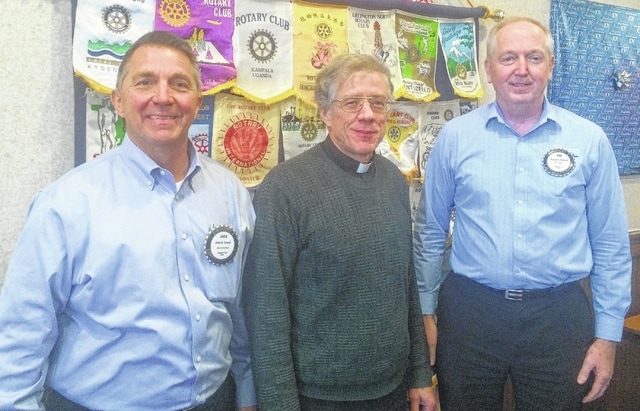
WILMINGTON — Father Mike Holloran recently spoke to the Wilmington Rotary Club which meets at noon about the story of Our Lady of Guadalupe and one of the Greatest Miracles of the Americas.
The Spanish explorer Cortes began his conquest of the Aztec Empire in 1519 and was declared victorious in 1521. Following the Conquest, the Spanish destroyed an Aztec temple and built in its place a chapel dedicated to the Virgin Mary. The opening of the New World brought with it both fortune-seekers and religious preachers desiring to convert the native populations to the Christian faith. One of the converts was a poor Aztec Indian named Juan Diego.
The Virgin Mary appeared four times before Juan Diego and one more before Juan Diego’s uncle. The first occurred on the morning of Dec. 9, 1531, when Juan Diego saw a vision of a maiden at a place called the Hill of Tepeyac, which would become part of Villa de Guadalupe, a suburb of Mexico City. Speaking to Juan Diego in his native Nahuatl language (the language of the Aztec empire), the maiden identified herself as the Virgin Mary, “mother of the very true deity” and asked for a church to be built at that site in her honor.
Based on her words, Juan Diego then sought out the archbishop of Mexico City to tell him what had happened. The bishop did not believe Diego. That same day, Juan Diego saw the Virgin Mary for a second time, she asked him to keep insisting and on Sunday, Dec. 10, Juan Diego talked to archbishop for a second time. The Archbishop instructed him to return to Tepeyac Hill, and ask the lady for a miraculous sign to prove her identity.
On that day, Diego returned to Tepeyac and, encountering the Virgin Mary for the third time and reported the bishop’s request for a sign; she consented to provide one on the following day (December 11).
By Monday, Dec. 11, however, Juan Diego’s uncle had fallen sick and Juan Diego was obliged to attend to him. In the very early hours of Tuesday, December 12, his uncle’s condition deteriorated overnight, and Juan Diego set out to fetch a priest to hear Juan Bernardino’s confession and minister to him on his death-bed.
In order to avoid being delayed by the Virgin and ashamed at having failed to meet her on the Monday as agreed, Juan Diego chose another route around the hill, but the Virgin intercepted him and asked where he was going. Juan Diego explained what had happened and the Virgin gently chided him for not having had recourse to her. In the words which have become the most famous phrase of the Guadalupe event and are inscribed over the main entrance to the Basilica of Guadalupe, she asked: “Am I not here, I who am your mother?”
She assured him that his uncle had now recovered and she told him to gather flowers from the top of Tepeyac Hill, which was normally barren, especially in December. Juan followed her instructions and he found Castilian roses, not native to Mexico, blooming there. The Virgin arranged the flowers in Juan’s cloak, and when Juan Diego opened his cloak before the archbishop on Dec. 12, the flowers fell to the floor, and on the fabric was the image of the Virgin of Guadalupe.
The next day, on Dec. 13, Juan Diego found his uncle fully recovered, as the Virgin had assured him, and his uncle recounted that he too had seen her, at his bed-side and she had instructed him to inform the bishop of this and of his miraculous cure; and that she had told him she desired to be known under the title of Guadalupe.
The bishop kept Juan Diego’s mantle first in his private chapel and then in the church on public display where it attracted great attention. On Dec. 26, 1531 a procession formed for taking the miraculous image back to Tepeyac where it was installed in a small hastily erected chapel.
Juan Diego’s cloak has become Mexico’s most popular religious and cultural symbol, and has received widespread ecclesiastical and popular support. In the 19th century it became the rallying call of American-born Spaniards in New Spain, who saw the story as legitimizing their own Mexican origin and infusing it with an almost messianic sense of mission and identity — thus also legitimizing their armed rebellion against Spain.


